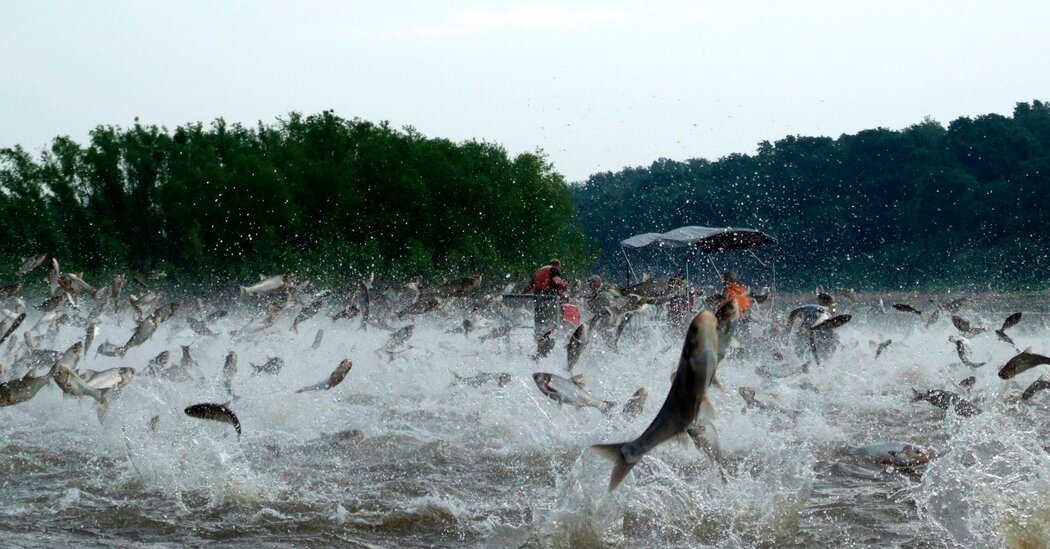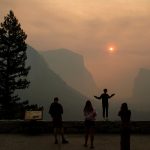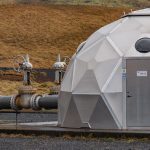
UNDER A WHITE SKY
The Nature of the Future
By Elizabeth Kolbert
A few years ago YouTube recommended I watch a video with the word “carpocalypse” in its title. I clicked the link — of course I did — and stared in awe at what resembled a mash-up of a video game, nature documentary and war movie. I saw a river full of fish leaping from the water like chaotic piscine fireworks and men in speedboats yelling and holding out nets to catch them as if they were wet and weighty butterflies. Fish hitting people in the face, fish landing in boats, fish flapping between people’s feet in a mess of slime and blood. This, the video informed me, was the annual Redneck Fishing Tournament in Bath, Ill., the object of which was to kill as many Asian carp as possible. An invasive species that has spread throughout the Mississippi basin since its introduction as a “safe” agent of biological control in the 1960s, Asian carp jump when they feel in danger, and the sound of boat engines is sufficiently alarming to push them en masse into the air.
The video was a startling coincidence of science, culture and environmental disaster, and I thought of it often as I read Elizabeth Kolbert’s excellent new book. I did so partly because her opening chapter deals with the continuing struggle to prevent Asian carp from entering the Great Lakes system, with solutions ranging from electrified water barriers to thrillingly impractical suggestions from members of the public to stop them with flying knives. But as I read on, I was reminded of the carp for a different reason. They seemed no longer just a sign of environmental disaster or a ready metaphor for xenophobia. In my mind they became proxies for us — creatures in mass panic, leaping out of their comfort zone, desperate to avoid catastrophe.
“Under a White Sky” is a fascinating survey of novel attempts to manage natural systems of all sizes, from preserving tiny populations of desert fish to altering the entire atmosphere (the title refers to the color the sky would turn were solar engineers to implement plans to spread mineral particles in the stratosphere to reflect sunlight and cut global warming).
One of the great science journalists, Kolbert has for many years been an essential voice, a reporter from the front lines of the environmental crisis. Her new book crackles with the realities of living in an era that has sounded the death knell for our commonly held belief that one can meaningfully distinguish between nature and humanity. Our world is too much changed for nature to be preserved simply by leaving it alone. “Humans,” she explains, are producing “no-analog climates, no-analog ecosystems, a whole no-analog future.” The systems that support us are now hybrid human-natural ones, and maintaining them increasingly requires us to adopt inventive strategies to correct for our previous attempts at control, efforts that have frequently led to highly unfortunate outcomes.
Kolbert has a phenomenal ability to communicate complex scientific information. She explains CRISPR gene-editing and atmospheric physics in prose that is a model of clarity and generosity; she traces environmental histories deftly. She moves us gracefully across numerous scales, from aerial views of clouds reflected in Louisiana lakes right down to an individual scientist picking aquatic beetles from a mesh screen, a fish egg with a visibly beating heart, a single gene. She has a marvelous eye for the quirky, from the plywood palm tree outside an Arctic research station to the local term for used condoms floating in water (“Chicago River whitefish,” a phrase I will never be able to forget, no matter how hard I try), and she wields figurative language in truly glorious ways: All the desert pupfish in the world, she explains, weigh less than a Filet-O-Fish sandwich. Isn’t that perfect?
All the while, we are introduced to a wonderful cast of people. She interviews scientists and engineers, coastal geologists, solar geoengineers, tattooed fishermen in gore-smeared overalls, a director of an Arctic institute with an icicle-hung beard and a Biloxi-Chitimacha-Choctaw chief living on doomed land. One frustration I had was the omission of Black voices in the chapter about land loss and environmental disaster in Louisiana. A significant aspect of managing natural systems has to do with the paternalism of such projects — the question of whether the people most affected by these endeavors have a say in how they are carried out.
Kolbert repeatedly turns to attempts by humans to recreate the natural world. She visits large-scale dynamic hydrological models; marine tanks in which corals are subjected to stress to assist their artificial evolution into hardier organisms capable of coping with our changing seas; the construction of a desert pool in a building that looks like an industrial warehouse. These spaces, strangely irrigated with both hope and despair, remind us that Earth itself is a discrete system under stress, the site of an experiment in survival we have busily been conducting on ourselves.
Though as a writer she has a transporting ability to conjure place and atmosphere, Kolbert can at times be a strangely elusive presence in her own book. At many points, I wanted desperately to know how she felt about things. When I read her assessment of the scenery surrounding her in northern Greenland — which “could be described as bleak, or alternatively, as sublime” — I blinked, curious as to which she preferred. Pointing out this personal reticence is not a criticism of her work: “Under a White Sky” is important, necessary, urgent and phenomenally interesting. It has, however, made me muse on the ways we choose to write about the environmental emergency.
In 2014, Kolbert was asked whether she found writing about extinction depressing. She said it was, but it had to be looked in the face. “I’ve tried to transcend my own feelings,” she explained. There’s good reason to do so: In such a politically charged field, honest sentiment is too often weaponized as evidence of bias and weakness. Furthermore, the voice of reportage, like the voice of scientific papers, carries enormous cultural power. It bespeaks objectivity. It’s the voice we are told to use when we want to be taken seriously, when we don’t want our conclusions to be interpreted as simply being emotional; we’re taught such things muddy the force of truth.
Yet the people who toil to stop invasive carp or preserve desert pupfish do so for reasons that do not exist solely in the realm of science. All the conservation biologists I know have deep attachments to the creatures they study, and it is these passionate motivations that spur their efforts and assist the continued survival of the creatures in question. I’m reminded of the words of Robin Wall Kimmerer, botanist, writer and member of the Citizen Potawatomi Nation, who maintains that science can be a path to kinship with other species, and that it should be animated by more than simply pure analysis.
Beautifully and insistently, Kolbert shows us that it is time to think radically about the ways we manage the environment; time to work with what we have, using the knowledge we have, with our eyes fully open to the realities of where we are. Rigorous analysis and science journalism, the form in which Kolbert truly excels, is needed now more than ever. But alongside it, to enrich it, there should be other stories too: tender, careful investigations into the feelings that drive and shape our efforts to save the world.


Average Rating